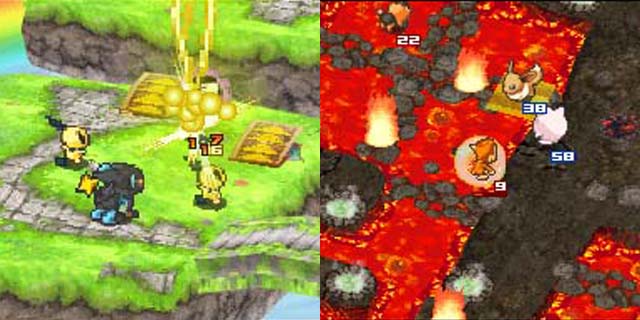
Since the very moment I was aware of both tactics games and Pokemon, I’ve wanted a Pokemon tactics game. It seemed like the perfect fit; while the series had all this fun customization and management, the real frustration was in the linearity and repetition of the one-on-one, menu-based battles. But despite the constant flow of spin-off titles, we weren’t getting it. Pokemon Dash, you guys? Really?
Apparently what it needed was some outside intervention.
Known as Pokemon + Nobunaga’s Ambition in Japan, Conquest is Tecmo Koei’s attempt to get more playing its particular brand of strategy games. Set in feudal Japan, you gather forces, take over castles and manage your kingdom in a way similar to classic Koei series like Romance of the Three Kingdoms and, of course, Nobunaga’s Ambition itself. Nobunaga himself serves as the villain for the main story, as his nefarious plans to take over all of Japan can only be stopped by you… um, taking over all of Japan.

But the battles are what this game’s about. Rather than wandering around with a team of creatures, you assemble armies of warriors, each with one Pokemon, to invade and train up. The areas are all maps similar to games like Final Fantasy Tactics and Disgaea, and they usually feature some sort of quirk. Think of them like gym battles, but not like the games. Like the show. One fire arena has lava everywhere and the danger of burning. A steel one has gears to turn and fences to disable, as well as a roving crane operated by a security system. These places feel different, and they legitimately change the strategy.
With all this complexity, the monsters themselves have been streamlined. Each has one move and one passive ability, and warriors have a once-per-battle special boost and an item slot. The move can’t be changed (except through evolution), so your fire guy has a range-2 Ember attack and that’s how it goes. It’s a refreshing change, though; each piece has a purpose, and you’re not just teaching the whole team Hyper Beam.

You’re not entirely stuck with the Pokemon your warriors start with. You can form “links” with wild Pokemon (as, I guess, the game takes place before the invention of the Poke Ball), and you can choose to use these creatures instead before heading into battle. They don’t have levels, though; strength and evolution are determined by increasing the “link percentage” between the two, so in most cases it’s best to stick with the one that knows ya. Sometimes, though, you can find the warrior’s “Perfect Link.” Each has one Pokemon it can attain 100% link with, and others are capped at some lower number.
When not in battle, you’re managing your kingdom. You tend to accumulate quite a few warriors along the way, and each area can hold six of them. You can use them manually to buy items, get gold and train against wild enemies, or you can use Conquest‘s “Delegate” feature. This allows you to assign a town’s forces to Develop, increasing money and boosting performance in the next battle; Train, increasing links with creatures; or Scout, finding new warriors and Pokemon for the cause. While you probably shouldn’t let them take care of important tasks or your top-tier forces, it makes things a lot more manageable to put your back-line cities on auto-pilot with the warriors not strong enough to worry yourself with. Moving these people around can be a bit of a pain, but anyone who’s ever played a Koei strategy game will find this incredibly streamlined and intuitive.

The “main game” actually serves as a sort of tutorial, with you conquering 17 castles, each with a type theme, and learning the ropes of the game to take down Nobunaga. After finishing it, Conquest opens up with a series of quests to take on, and the Wi-Fi function enables new warriors and quests as well. It’s important to know that much of what you do in each campaign is self-contained; while you can build up access to things and certain aspects over playthroughs, you’ll still have to find and beat your old friends to get them to join you in a new endeavor.
There are a few gripes I definitely need to mention, though. The most glaring is a particularly unfortunate button mapping during battles. If you select a Pokemon, hitting X allows you to access the warrior ability and item, and you’ll do that often. If you’re not selecting a Pokemon, though, X is the End Turn button. When your cursor is highlighting a Pokemon, it’s hard to distinguish from how it looks when it’s selected, so this will come up often. Thankfully, it asks for confirmation. (We tried using the touch screen controls, but they just aren’t very reliable with the isometric, tilted camera.) Besides that, there are just weird things, like recycled warrior portraits. At any given point, you’ll have six Guy With Green Hat warriors, four Chubby Old Beard Guys and a handful of Nervous Bespectacled Fellows. The really good ones are unique figures from Japanese history, but your second string gets really hard to distinguish.
Pokemon Conquest is the game I was hoping it would be. There are certainly elements that could be fixed or built on in a sequel, and I hope Nintendo lets Tecmo Koei make one. Even as it stands now, though, it’s a breath of fresh air in both the tactical RPG genre and the Pokemon series, and there were a lot of oxygen-deprived fans of both out there.
Pros: Deep combat, large amount of “post-game” content
Cons: Weird button mapping, recycled warriors



















